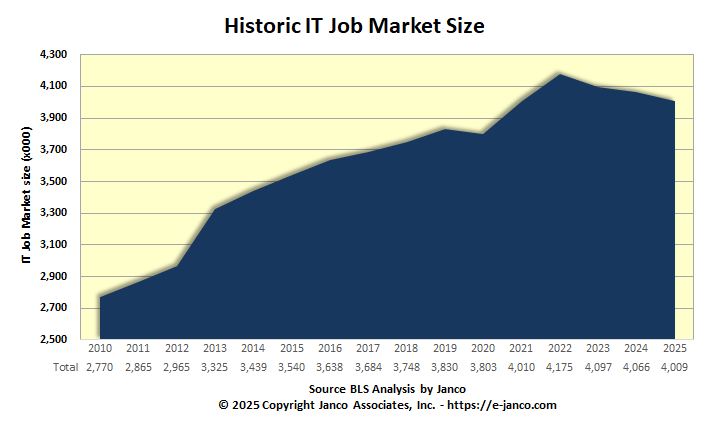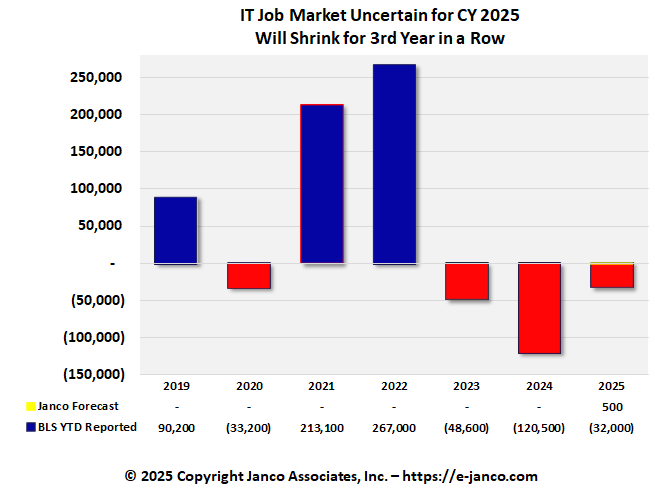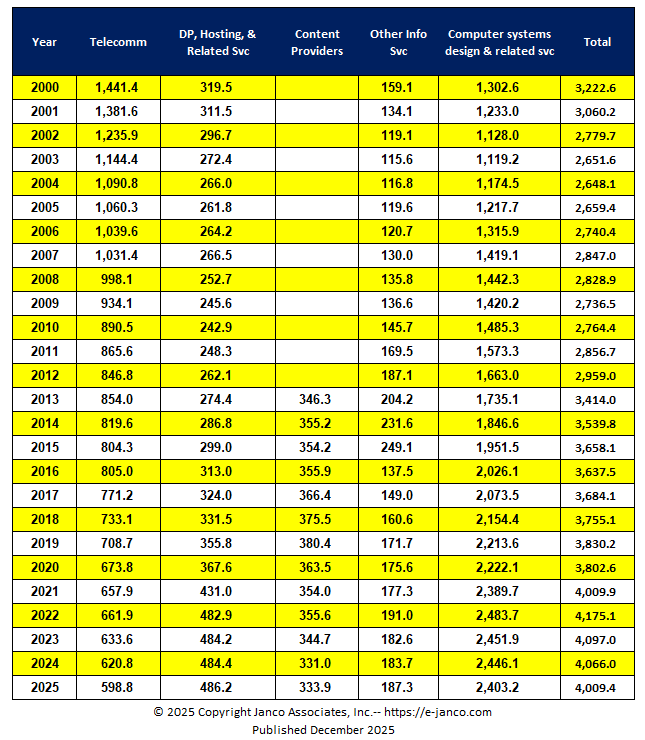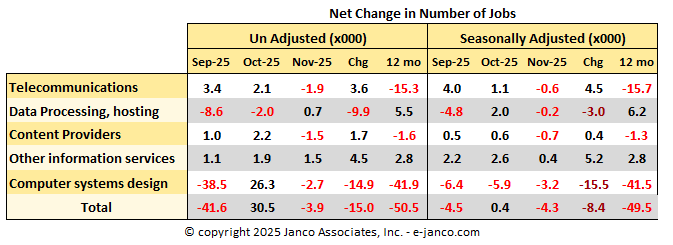 Report paints bleak picture for IT jobs in 2014
Report paints bleak picture for IT jobs in 2014
By Serdar Yegulalp | InfoWorld
Employment report shows 1,400 IT jobs were lost in January, hiring is at a standstill, and IT wages lack growth
Report paints bleak picture for IT jobs in 2014 - The overall U.S. unemployment rate, but that hasn't translated into good news for IT workers seeking a position. Although the economy added some 113,000 jobs in January, the IT hiring picture has all but ground to a halt. If anything, it's drifting backward, with 1,400 IT jobs lost in January.
Net Change in Number of IT Pros Jobs
IT Hiring Slows - IT Pros Face Shrinking IT Job Market

Janco forecasts that the IT Job Market Will Shrink Again in FY 2025

Updated with the latest data
IT Hiring Plummets IT Unemployment Rate 5.0% InNovember

The latest data for more read on...
Note - data includes the adjustments by the BLS to the initially reported data.Subscribe to our Newsletter to get this information delivered to your inbox as soon as it is released. SUBSCRIBE
Labor Force Participation
Labor Participation Rose Slightly
More people are choseing not be active in labor market
103.2 million people in the U.S. are not counted in the labor force - see reasons why not working.
Subscribe to our Newsletter to get this information delivered to your inbox as soon as it is released. SUBSCRIBE
Janco Associates, which tracks IT hiring in the United States, released its analysis of the January employment picture for IT, and the picture's uniformly bleak.
Janco began warning of a bad year ahead for IT workers after it spoke early last month to more than 100 CIOs across the industry and found they were all either in a holding pattern or cutting back as far as hiring went.
That picture is unchanged in the latest such poll by Janco, and the rest of its statistics remain downbeat as well. Apart from a spike of some 37,800 hires in November, probably due to seasonal work, the number of new IT jobs never exceeded 11,200 for any month in 2013. Worse, the overall participation of workers in the labor force hit a low of less than 63 percent in December -- the lowest since the 1970s -- and lifted barely half a percentage point in January.
It's also worth noting that some 80 percent of that decline over the past two years has been due to retirement, where people opt to simply leave the workforce and draw Social Security or a pension rather than continuing to look for work. But new job positions are not being added in the wake of many of those departures.
Much of this lethargy seems reflected in other all-around economic sluggishness. Wages have remained stagnant, IT wages included, although IT wages tend to outpace the national average for other workers. It lends credence to the idea that the "STEM crisis" is more about reduced hiring than the lack of qualified workers.
For contrast, compare the IT hiring picture in the United Kingdom, where job vacancies are back up to levels not seen since May 1998, and pay rates are being stimulated by high demand for software developrs and general IT personnel.
In the United States, though, IT workers on the whole experience ower rates of unemployment -- around half as much -- as the general workforce. Those who get into IT in one form or another tend to enjoy better opportunities for work, although the numbers vary depending on the specialty. Support specialists, for example, are some of the most under-employed, while experienced network architects rarely have trouble finding work.
The biggest IT job markets for 2014 are believed to lie in mobile, Web development, and big data work, with the last seen as the strongest draw. Software engineers with QA and testing experience are also expected to be in demand again after many of those positions were eliminated and people switched job tracks. But the size of that demand and the compensation provided are likely to remain constrained by the economy's limited expansion.
Historic IT Job Market Size

Data complied by Janco Associates with data as of August 2025
Subscribe to our Newsletter to get this information delivered to your inbox as soon as it is released. SUBSCRIBE
Order IT Hiring Kit Download IT Hiring Kit TOC








